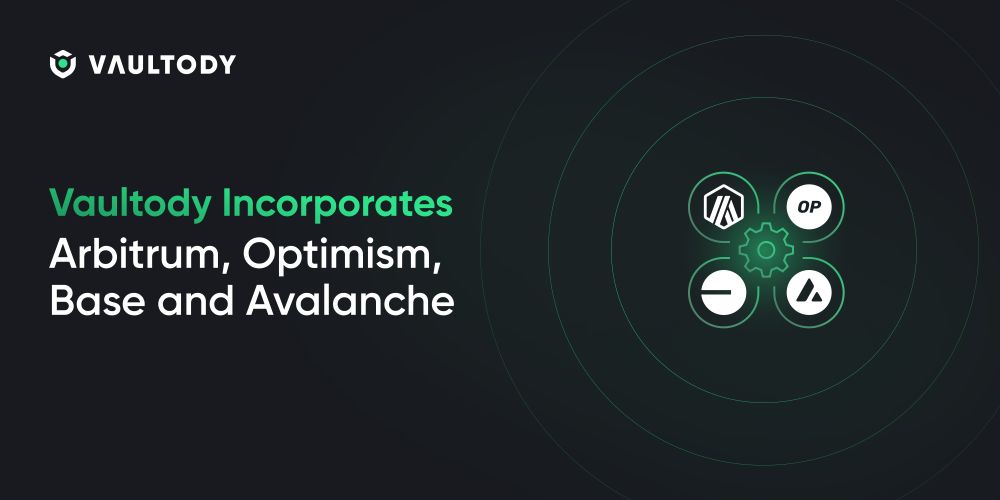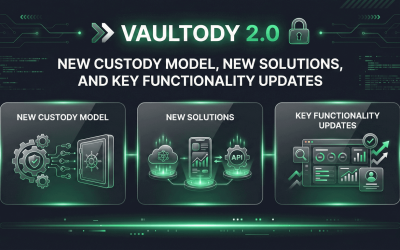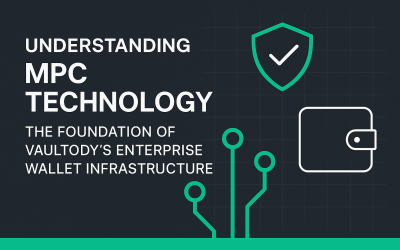Vaultody is a thriving ever-growing platform for companies and institutions to securely operate with their digital assets. What makes it uniquely equipped though, is the ability to provide diverse alternatives for the successful completion of that goal. By utilising our General, Automation and Smart Vaults’ innovatory solutions, customers can rest assured that they have exactly what they need to operate with their assets without a hitch.
Nevertheless, our team does not stop there. We strive to provide the best service possible that both matches the market’s demands and customer requirements. Thus, the continuous onboarding of new blockchain protocols and networks is a must for us.
On that note, we are proud to announce the incorporation of the latest protocols into Vaultody - Arbitrum, Optimism, Base and Avalanche C-Chain. Customers can now safely operate with, manage, store and transfer their digital funds on these protocols across all three Vaults - General Vault, Automation Vault and Smart Vault.
Why prioritise these four blockchain protocols?
In their few short years of being active (some even less than others), Arbitrum, Base, Optimism and Avalanche C-Chain have proven to be reliable, cost-efficient and often of first choice. They are all Ethereum-based and designed to work with EVM-compatible smart contracts. Their advantages are why we prioritised them for integration:
1. Scalability - all four improve transaction throughput and reduce data blockage on their networks, which practically scales the main chain’s operational capabilities;
2. Low fees - all four offer lower transaction fees compared to the Ethereum mainnet, making them more appealing for users and developers;
3. Smart contracts - all four support Smart contracts;
4. EVM Compatibility - all four are EVM-compatible which means that Ethereum-compatible smart contracts and dApps can be deployed on their platforms without major modifications.
Arbitrum
Arbitrum is a relatively new Layer-2 scaling technology, launched in mid 2021. Built on the Ethereum blockchain, it offers an inventive solution to its scaling issue. Arbitrum helps the main chain to offload most computational and storage loads. It facilitates higher efficiency by improving the network’s transaction speeds and ensuring lower execution fees by using a technique called “optimistic rollups”.
Optimistic rollups are essentially a method of processing and executing transactions off-chain after which they are batched together into a single transaction and submitted back to the main blockchain, i.e. Ethereum main chain.
In this scenario Arbitrum plays the role of a much less-expensive side chain. Meanwhile, parallel to the entire process the main chain, Ethereum, maintains security and ensures correct results. With the help of Arbitrum, Ethereum is considered more user-friendly and scalable. Moreover, this Layer-2 tech is now a growing ecosystem accommodating multiple projects and applications, with growing popularity among developers, increased adoption of its features and use of its network.
Base
Base is another Layer-2 technology introduced in the beginning of 2023. It was developed by Coinbase to specifically support decentralised applications, i.e. dApps, as well as to improve Ethereum’s utilization.
Base operates similarly to Arbitrum, where it performs and processes the heavy transaction loads making fees on the main blockchain much lower, performance higher and settlement time - less. In contrast to Arbitrum, Base also uses OP Stack, which is an open-source development framework for building and scaling L2 Ethereum solutions. It was developed by Optimism, another L2 scaling Ethereum solution.
Being a Coinbase developed technology, Base can take advantage of the exchange’s services and user base, which for customers means easier access to their offered crypto and blockchain services. It inherits the main blockchain’s security measures and thus provides a safe environment for faster and less-expensive transactions.
Base is another example of a Layer 2 scaling solution for Ethereum, making it a more preferred and better performing blockchain with every passing day and transaction.
Optimism
Another example of an auspicious Layer 2 scaling network for Ethereum is Optimism. It was introduced in 2020 and designed to reduce fees and increase transaction throughput. Through the years since it has become a noteworthy scaling solution for Ethereum.
Some of its main features include optimistic rollups, which lead to faster processing times and lower fees, fault proofs, which determine a transaction’s legitimacy on the optimistic rollup before it is submitted back to the main chain, and overall better user experience.
The Optimism establishment behind the namesake protocol is described as not just a company, but an entire “collective” or “ecosystem”, responsible for the development of also OP Stack (preferred by many for development of a L2 scaling solution), Superchain (Optimism’s concept of interconnected L2 chains built using OP Stack), Optimistic Rollups (a technique of executing transactions off-chain then batching them up together and submitting them back to the L1 blockchain), and more.
Avalanche C-Chain
Avalanche C-Chain (short for Contract Chain) is a Layer 1 blockchain, operating independently within the broader Avalanche network, along with X-Chain and P-Chain. It is fully compatible with EVMs and was released in 2020 with the idea to deploy dApps and smart contracts in a highly interoperable and scalable infrastructure.
As a L1 chain, Avalanche C-Chain uses Avalanche’s special consensus mechanism (based on classical and Nakamoto consensus) and does not rely on another layer to process transactions or data load. As an EVM-compatible blockchain it allows for the easy deployment of dApps across Ethereum and other EVM-compatible chains.
Much like Arbitrum, Base and Optimism, Avalanche C-Chain offers lower than Ethereum fees on a general principle, making it a much preferred protocol. Moreover, through its unique architecture, it can expand horizontally, making it capable of executing a large number of transactions without compromising performance, all through running multiple chains simultaneously through subnets.
How to best benefit from this integration with Vaultody?
1. Save on fees - Lower your transaction fees by taking advantage of our Smart and Automation Vaults. By using our feature “station address” you can centralize all transaction fees and eliminate wallet dust;
2. Create transactions easily - manual or automated through predefined rules, simply choose your General, Smart or Automation Vault;
3. Same address for all EVM-based chains - use a unified address for all supported EVM chains and in doing so eliminate human errors when creating transactions and effortlessly manage your digital assets;
4. Smart Contract Protocols - use your Smart Vault, specifically designed for managing funds on smart contract supported protocols;
Our latest update on onboarding the blockchain protocols Arbitrum, Base, Optimism, and Avalanche C-Chain marks a significant step forward in enhancing the capabilities and efficiency of Vaultody.
Stay tuned with our Blog to learn what new comes next!









 Copy link
Copy link